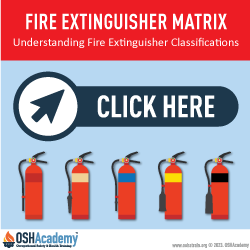Fire Extinguisher Ratings
There are five types of portable fire extinguishers. Each type is rated to extinguish a specific class of fire.
Newer fire extinguishers use a picture/labeling system to designate which types of fires they are to be used on. Older fire extinguishers are labeled with colored geometrical shapes with letter designations. Both types of labels are shown below with the description of the different classes of extinguishers.
Check out the Fire Extinguisher Matrix to see how extinguisher ratings and mediums used to fight fires match up with the classes of fires.
 |
Class A Extinguishers are required anywhere ordinary combustibles are present. Fires involve materials such as wood, cloth, rubber, paper, and many plastics. The numerical rating for this class of fire extinguisher refers to the amount of water the fire extinguisher holds and the amount of fire it will extinguish. |
 |
Class B Extinguishers are required for fires involving:
AFFF (aqueous film-forming foam) and FFFP (film-forming fluoroprotein) fire extinguishers are rated for use on both Class A and Class B fires. As the name implies, they discharge a foam material rather than a liquid or powder. |
 |
Class C Extinguishers are suitable for use on electrically energized fires. The presence of the letter "C" indicates that the extinguishing agent is non-conductive. To get the C rating the extinguishers are tested to see if any electrical current flows through them as they are discharged on energized electrical equipment. You won't see an extinguisher with only a C rating: they will always have an A and/or B rating as well. Carbon dioxide extinguishers are listed for use on Class B and Class C fires. The advantage of using CO2 is that it does not leave a lot of residue on electrical equipment. |
 |
Class D Extinguishers are designed for use on flammable and combustible metals, such as magnesium, titanium, zirconium, sodium, lithium, and potassium. These extinguishers generally have no rating nor are they given a multi-purpose rating for use on other types of fires. Extinguishers and agents for use on combustible metals fires are rated for the amount of agent and the method of application needed to control the fire. |
 |
Class K Extinguishers, or Wet Chemical, fire extinguishers are designed specifically for use in restaurant kitchens where fires in cooking appliances that involve combustible cooking media (vegetable or animal oils and fats). They utilize a potassium acetate based, low PH agent - the same agent used in pre-engineered cooking equipment fire extinguishing systems. The agent discharges as a fine mist which helps prevent grease splash and fire re-flash while cooling the appliance. The Class K extinguisher is the ideal choice for use on all cooking appliances including solid fuel charbroilers. |
Knowledge Check Choose the best answer for the question.
5-4. Which class of fire extinguishers should be used on fires involving flammable liquids, such as grease, gasoline, and oil?
You forgot to answer the question!

